This was published 2 years ago
‘I can’t stand the sound of rain’: The grief that’s united a region
While the catastrophic flooding on Australia’s east coast in February and March left the NSW Northern Rivers in chaos, it also bonded its people like never before. That community spirit is being harnessed as the region sets about the enormous challenge of rebuilding.
By Candida Baker
Karri Crossing and Hayden Muirhead with one-week-old baby Ziggy and daughter Juno; Lismore after the flood peaked on February 28; A Lismore street, days later; A warning sign on a fence of a home along the river in Woodburn.
At some point in our lives, we all come to understand the fundamental stages of grief. We traverse the landscape of loss repeatedly, and yet deep within us, however hard it is to see it at the time, lies a small reservoir of hope that one day our wound will heal. What if, however, the wound is so deep, so open, that it seems impossible to bear? What then?
On the weekend of February 26-28 this year, much of the east coast of Australia changed irrevocably as floods raged over thousands of kilometres, from south-east Queensland to Sydney and beyond, a disaster in which 22 people died – 13 in Queensland and nine in NSW. But it was in the city of Lismore, in the heart of the Northern Rivers, where the floods broke all records, reaching 14.37 metres, two metres more than the 2017 flood, a full two metres for which there was no warning, until, for many, it was too late.
I’m talking to 41-year-old Lismore resident Karri Crossing, who lost everything, and is now staying in a cottage she and her partner, Hayden Muirhead, have been lent by friends. The little weatherboard house is nestled on a ridge behind Byron Bay, and the landscape between the hills and the ocean are still, five weeks later, full of inland lakes. Her six-year-old, Juno, has hijacked our conversation and is explaining the flood to me.
“Horror!” she says, starfish hands stretched out wide. “It got worser and worser.” Crossing nods. “It did, didn’t it?” she says.
“Yes! And you thought, ‘How do you save your kids?’ ” Juno says matter-of-factly, her curly hair falling in her eyes as she bends over her colouring book.
“Yes,” says Crossing gently. “That’s true.” Her six-week-old baby, Ziggy, is asleep in a baby carrier on her chest, his head peeking out of the top. He was one week old when the flood waters rose so quickly that Crossing and Muirhead, 42, had to make the decision to climb onto the roof of their home, with Juno, Ziggy and their cat Toki, to save their lives.
“We talked about leaving earlier,” she says, “but the 2017 flood hadn’t reached us, and neither had the 1974 flood. It’s my mother’s house, two storeys, with high ceilings and cement tilt-slab walls. We lived in the top floor over a shop, so based on all the predictions, we felt relatively safe.”
But when Crossing woke at 3am to feed and change Ziggy, she looked out of the window at the quickly rising water and knew they were in trouble. “I opened the curtains and less than a metre below the second-storey windows was a huge, dark, swirling mass. I can’t really explain the feeling of dread,” she says. “It was only minutes before the water was creeping through the floor, and it was greasy, cold, dark and stinking.”
“The water was hip-high when the fridge went over, and I think that’s when I just went into survival mode. I knew we had to get out.”
Thinking back to that moment still makes her physically sick. “My babies were asleep in their warm beds, while the building was beginning to creak like the Titanic, and I could hear the eerie sirens that meant the levy was over-topped,” she says. “The lights went out, but I could see a light from a power switch under the water and I was terrified we would get electrocuted. We were trying to stay calm for Juno, but it was hard, particularly holding a baby close to me at the same time as trying to do what I needed to do to survive.”
They put a mattress on the kitchen table and placed Ziggy in his aptly named Moses capsule. “The water was hip-high when the fridge went over,” she says, “and I think that’s when I just went into survival mode. I knew we had to get out.”
A few weeks later, I’m with Hayden Muirhead outside their ruined home. The New Zealander, who lived through the 2011 Christchurch earthquake, says: “The quake was violent and overwhelming. The flood has been insidious and toxic, and the after-effects aren’t even over yet. Due to a sewage-plant breakdown, the flood waters were full of raw sewage, and the infection risk for Karri’s caesarean wound was a real concern.”
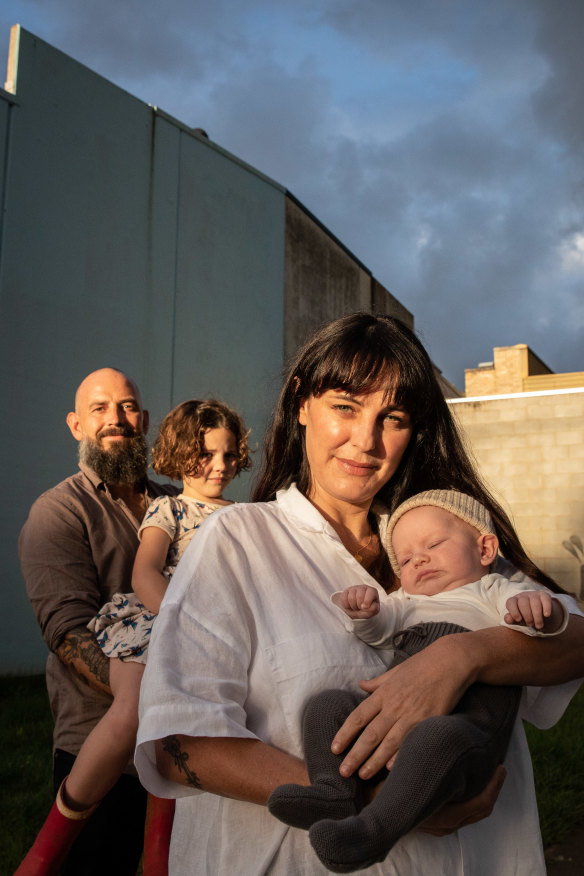
Karri Crossing and Hayden Muirhead had to climb onto their roof with one-week-old baby Ziggy and daughter Juno, 6, to survive the “horror” flood.Credit: Paul Harris
One of the strange things about being in flood water, people have explained to me, is that objects, soft and hard, bump into you. You can’t think too much about what it is touching you as you grope blindly underwater for the stairs that might be washed away, for the ladder that you pray will lift you one rung higher towards safety. A perilous safety at that, on a roof in the driving rain, as all manner of creatures – snakes, rodents, cats and dogs, even, in this flood, cows and horses – try to find refuge. Crossing, who had given birth via a caesarean only a week before, had had mastitis and was on antibiotics. “It only occurred to me recently that it was a good thing I was on medication,” she says. “I hate to think what kind of infection I could have got.”
The family, Crossing says, was fortunate. Although neither she nor Muirhead could get through to the SES or triple-zero, her mother, who was out of the flood zone, kept calling, and her sister-in-law, an SES volunteer, also stayed in constant touch with them. Because they had a newborn, they were finally made a priority and were rescued after a few hours.
“We had to leave Toki,” says Crossing. “He hid under the solar panels on the roof for three days, and then when Hayden was finally able to kayak to the roof to get him, we couldn’t believe that he was still alive. We took him to my mother’s, and he’s still there. His survival helped with my trauma of having lost everything. I had my phone in one pocket, and a dummy in the other, and that was that.”
Only four weeks and one day later, there was a second flood. It would have been hard to find anyone in the Northern Rivers who slept that Tuesday night as the rain beat down relentlessly, and anxiety levels spiralled sky-high.
“The idea that my children’s lives were in danger still terrifies me today. It makes me feel sick with anxiety to tell my story.”
“I was up all that night,” Crossing says. “When we were on the rescue boat, we were going over and under fallen power lines. I kept thinking about climate change and climate emergency. It was always at the back of my mind, now it’s at the forefront; it’s scary. “You feel powerless, wondering how the world will survive these weather events. The idea that my children’s lives were in danger still terrifies me today. It makes me feel sick with anxiety to tell my story. After we were rescued, another family got into the boat; the other mum and I looked at each other, and we both just started crying.”
All of us in the Northern Rivers knew that there was an event coming. It had been raining since November last year. South-east Queensland was flooding and the water was pushing an inexorable path south. By the morning of February 27, a Sunday, flood plans were well in place, and as everyone went to bed that evening, the Bureau of Meteorology was predicting a flood peak of 11.5 metres, below the 2017 level. But in the middle of the night, people woke up to the sound of water rushing into their homes, and to the news that the peak height had been revised to 14.5 metres. It was the beginning of an unprecedented natural disaster.
Lismore grew up as a logging village on the banks of Wilsons River, in the heart of Bundjalung country, and as a city, it has always embraced non-conformity. Its population of approximately 30,000 includes traditional farming families, small-business owners, teachers and students, strong LGBT and Indigenous communities, tree-changers and alternative-lifestyle followers, deeply rooted in its society since the first protesters arrived in the late ’60s to stop the logging of old-growth rainforest.
Many of the city’s gracious old buildings date back as far as the 1890s. It is – or was – the diverse and educational heart of the region, hosting Southern Cross University, a conservatorium, a TAFE, a cathedral, a library, a new regional art gallery, two major Catholic schools, two public high schools – Lismore High School and Richmond River High School – a public and private hospital, a large civic centre housing the regional theatre company, a shopping centre that was purpose-built outside the CBD, along with the supermarkets, civic infrastructure and independent shops that made up the city’s core.
One morning while I was writing this story, I went to make a cup of tea, and I noticed a chip on my favourite cup. A fleeting thought occurred to me that I should go into Lismore and get another Maxwell & Williams mug from the china shop. Then I remembered. The shop is no longer there. There are no shops. Everything went under – banks, offices, clothing stores, cafes, newsagencies, the library, homes and civic buildings. And not for the first time, I wondered: how could a region come back from this level of devastation?
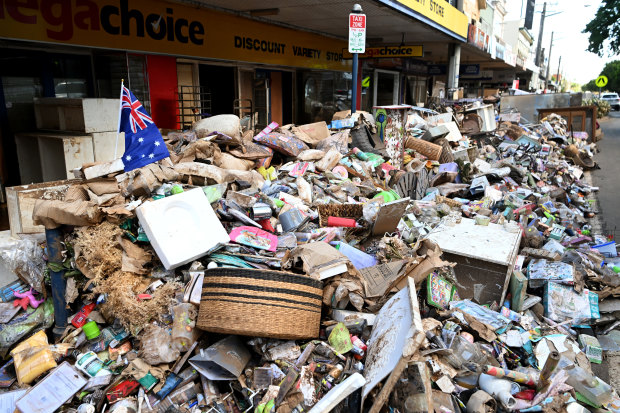
Piles of flood-damaged goods line a main street in central Lismore. Credit: Getty Images
It took us five days to be able to get off our hill and through the flood waters towards Lismore. As we took that first drive, what struck me was the sheer force of the water – two giant shipping containers tumbled like Lego pieces, furniture high in the treetops, piles of mud-stained and broken things that had made up people’s lives outside every house, shop, factory and building.
On the way to the small town of Coraki, we drove past dead cows strung on barbed-wire fences, and the town’s sign, “Welcome to Coraki – The Meeting Of The Waters”, was heart-rendingly accurate. From the edges of the riverbanks, owners of boats and jet skis were loading up with supplies for people and animals stranded throughout the saturated landscape, as the thick smell of decay hung in the air from the now bacteria-ridden water and mud.
But despite the damage, there are many people who believe the region can come back, as it did after the 2017 floods. John Stewart, 54, the founder of Lismore’s Living School, remains optimistic that the Northern Rivers, and Lismore in particular – the city he grew up in – can not only recover, but thrive.
Stewart vividly recalls the 1974 flood: “I was seven,” he says. “My father was a doctor, and our home was also my father’s practice – and the house where I started the Living School in 2020. The water came into our home by about a foot. I remember sitting upstairs and looking out at the floodwaters as all these animals – budgies, mice, cats and dogs – all came past, and just staring out of the window watching all the rescue boats. But we came back from it.”
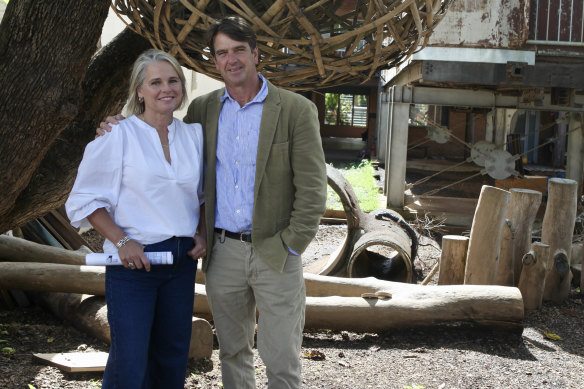
John Stewart with wife Sophie Moeller. The flood taught him “how bloody good people are”.Credit: Candida Baker
He graduated with a master’s in education from the University of Cambridge in 2001 and has worked in the field many years. He believes that the pillars of progressive education, community and resilience feed into each other. “My wife Sophie and I came back to this area in 2015 because my roots are here, because I love it. I want my grandchildren to walk the streets where I walked, and I know we could put into practice elements that will be needed in every river town in the coming generations.”
Stewart feels that the waste of the original old hardwood in the ruined buildings is tragic. “It’s remnants of the Big Scrub, and it’s being dumped for landfill owing to flood contamination. We should find a way to clean and save the hardwood and be focused where possible on re-use and recycling, exploring the potential of flood-resistant materials in the mix. It’s important to continue to embrace the fact that it’s the river that brings fertility to the region, and that it’s possible to mitigate against flood damage.”
Stewart and his wife, Sophie Moeller, 56, are indefatigable in the face of adversity. Within weeks of the flood, the Living School had hired architects from the Cave Urban design studio, whose Flow installation is the centrepiece of the rivus exhibition at the 2022 Sydney Biennale. The exhibition is based on the concept of rivers, wetlands and other water ecosystems, underpinned by the notion that sustainability is not just an idea, but something we all need to work towards.
His positive spin extends even to the physical aftermath of the disaster. “If you look at the piles of detritus, and remember that every piece was put there by someone who volunteered or helped, then you see the extraordinary community spirit manifesting in this trauma,” he says. “What I learnt from the flood is how bloody good people are.”
Wilsons Creek resident and business owner Rich Latimer was one of those “good people”: he chose to step up to coordinate the civilian air response to the floods. It was also Latimer who, tired of waiting for Prime Minister Scott Morrison to appear at his Lismore press conference, took the microphone and gave a heartfelt plea to the authorities to listen to the local desire for a unified community and government reaction to the disaster.
“I live in one of the worst-hit areas, not far from Mullumbimby,” explains Latimer, 44. “We had to dig our way out with shovels and a small tractor, and several people died in the landslides that engulfed us. Once I was out, I knew that I needed to do something. “When I got to the Tyagarah airstrip, outside Byron Bay, where the helicopters were taking off from, there was no one official there, and so that’s how it began. I took control of the air response and integrated how agencies connected to each other.”
What he came to understand quickly was that there were no protocols in place for a natural disaster. “We have to – and this is not a utopian vision here – have a system where civilians, agencies, governments and media work together, where red tape can be cut through, where we can all be unified,” he says. “We need a sensation of hope for the future, because already I’m seeing a huge rise in depression and anxiety, which is inevitably going to lead to a spike in suicides. We urgently need a plan that covers everything from the moment a disaster unfolds to the care that is needed for the communities after the event.”
“We need a sensation of hope for the future, because already I’m seeing a huge rise in depression and anxiety.”
Latimer points to the local SES as an example. “They did a great job, but they are not equipped to adequately respond to disasters,” he says. “There are 48 of them in this region, they’re volunteers and many of them are not that fit or that strong. At each instance when SES personnel told civilians to stop rescuing people, most simply took no notice. They went on rescuing, and if they hadn’t, hundreds of lives would have been lost. At the very least there needs to be a commitment from the federal government that a natural disaster will automatically be classified as a military operation, so that the military can be on the ground, and in the air, within hours, not weeks.”
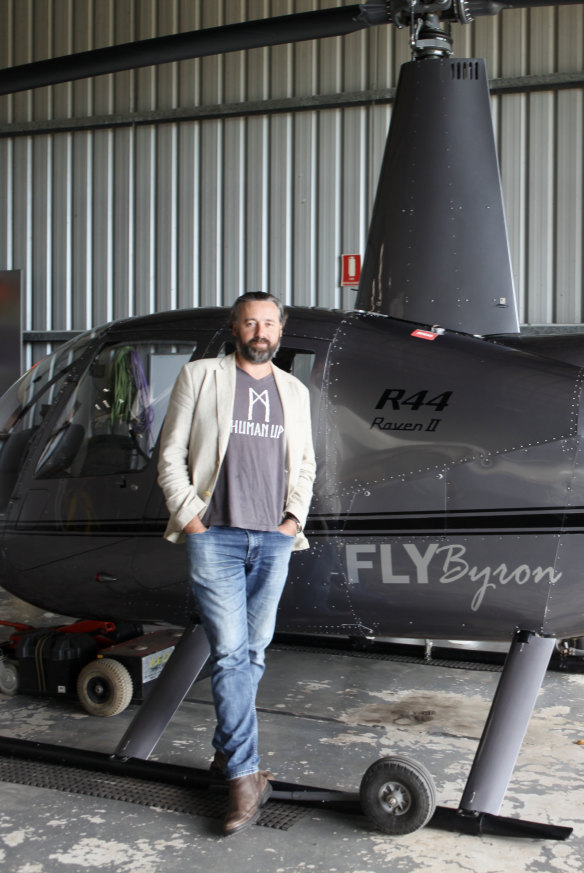
Rich Latimer took on the job of co-ordinating the air response from the hangar at the Tyagarah airstrip, outside Byron Bay. “There was no one official there, and so that’s how it began.”Credit: Candida Baker
Justine Elliot has been the ALP member of parliament for the seat of Richmond since 2004, an area which stretches from the NSW-Queensland border south to Ballina and Pimlico. Many of the towns in her electorate, including Mullumbimby, Murwillumbah and Tweed Heads, flooded.
She believes the official response was inadequate. “NSW has no emergency disaster planning, which is a huge failure,” she says. “People need emergency housing, ongoing disaster payments and mental-health support as a minimum. We need an over-arching system with a chain of command and organisational procedure.
“The federal government should look at why it took so long to get the army there, and at the big issue of communication difficulties – in many places there was no NBN, there was no mobile and no internet. Social media was invaluable, but it should be part of the response, not the response. The village of Newrybar set up their own satellite to provide communication – if a tiny village can do it, surely a government can set up an emergency communications network?”
Elliot is also angry at what she sees as the politicising of the response. “We are a Labor seat, and when the first flood disaster payments were announced, Richmond was not included – Page, a Nationals seat, was,” she says. “A natural disaster response has to be above politics.”
To locals, PM Scott Morrison’s single visit on March 10 seemed to be a case of too little, too late, but the NSW government’s recent creation of the Northern Rivers Reconstruction Corporation (NRRC), which has bipartisan support, has created some goodwill across the political divide.
Labor’s Janelle Saffin, the Lismore state MP who was instrumental in pushing for the NRRC, had first-hand experience of the floods. “My husband was at our house, and I was at a friend’s place,” she says. “Our house went under, with the water almost up to the ceiling, and my husband nearly drowned before he was rescued by Julz Parker from the band Hussy Hicks.
“It was clear to me right from the start that the disaster programs that exist don’t cover the entire architecture of a disaster. Grant by grant just won’t cut it. We needed – and need – physical, financial, emotional and environmental support, and it must cover the whole of the Northern Rivers.”
According to Saffin, it was clear from the outset that Resilience NSW – the state agency created in the aftermath of the 2019-20 bushfires – was not up to the job, a sentiment echoed by many others in the region. She believes it should be disbanded, with its funding sent to the SES to transform it into a professional combat rescue agency, and a standing disaster-management authority, such as Queensland’s, should be developed.
The NRRC has committed to setting up about 2000 modular homes, and Saffin has been pushing for land swaps, voluntary house-raising and voluntary house repurchase, at a pre-flood price so that people have a chance to build or buy on higher ground. “I’ve been working with the NSW Premier and the leader of the opposition,” she says, “and I think in David Witherdin, who is a civil engineer and heading up the corporation, we have someone who understands both the complexity and the urgency of the task ahead.”
Ten weeks after the floods, 61-year-old Dean Wilson still can’t go home. “My house has been contaminated by an oil spill and deemed so toxic that I’m not allowed to touch anything or go inside and start the clean-up,” he says. “All my furniture and most of my belongings are still inside. It’s all a write-off. The EPA [Environmental Protection Authority] are organising a clean-up team to decontaminate everything, but I’m still waiting to find out how they’re going to do it and how long it will take.”
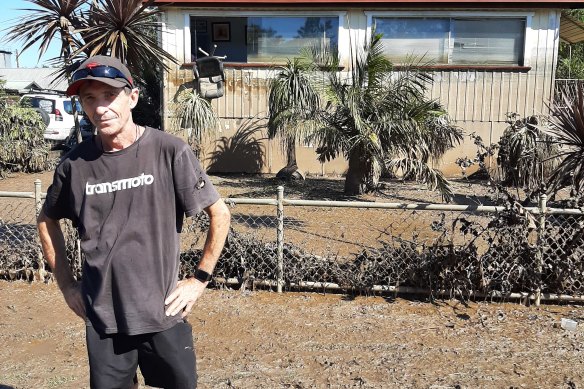
Dean Wilson outside his house in Broadwater, which had never flooded before and is now uninhabitable due to a covering of toxic sludge.Credit:
Twelve years ago, when Wilson bought his weatherboard cottage in Broadwater on the old Pacific Highway, next to the BP station and up the road from the sugar mill, the area had only ever flooded a couple of times, most recently in 1974. Wilson, who was semi-retired having run the local caravan park for many years, set about creating the place he wanted to be his final home, with a granny flat for extra income and a vegetable garden. When the new freeway opened a few years ago, Broadwater became part of the tourist and residents’ route linking the picturesque villages and towns along the river to Grafton.
Even in the early hours of February 28, he wasn’t unduly concerned. “My flatmate and I had heard by midnight that Woodburn was in trouble, but there was no indication we were going to be badly flooded. I stayed up until 3am and the water was only about six inches deep in the yard, the high tide had come and gone, so I felt safe enough to go to bed. When my flatmate, Nat, went to bed at 6am, it wasn’t that much higher.”
One hour later, it was a different story. “I got up at seven and saw a little pool of water in the bathroom. I opened the back door to find my place surrounded by a lake that was about to come into my home.”
Wilson’s car had been completely submerged, and the property across the road was about to be swamped. “By 7.30am, the water was knee-deep through the house and still rising. There were boats going up and down on what’s usually the old highway – it all happened so quickly, it was surreal. We managed to flag down an SES boat, grabbed what we could, then we climbed out through the front window and straight into the boat.
“I woke up and next thing I’m floating down the Pacific Highway in a frigging boat. I took a painting of my dog Buster, who died a few years ago, grabbed a few T-shirts and shorts, put some cold beers in the esky, and that was it. Nat and I lost everything in the space of an hour.”
What happened to his house during the flood is still not clear, but when Wilson finally managed to return a week later, he found everything from the walls to a frying pan he’d left near the sink covered in a thick, smelly, dark-brown sludge, which he believes came from a depot that services sugarcane-mill trucks behind his property. He alerted the EPA.
When they arrived, they took one look at his place and donned HAZMAT suits. A few days later, he was told the house was too dangerous to enter, but after some pleading, they let him suit up as well. “I was allowed 10 minutes inside the house, with an escort. Ten minutes to sort through my entire life’s possessions, find stuff and decide what to take and what to leave,” he says. “I felt like I was suddenly in a bad science-fiction movie. And nobody could tell me what the sludge was, or where it came from.”
“I felt like I was suddenly in a bad science-fiction movie. And nobody could tell me what the sludge was, or where it came from.”
Wilson’s frustrated that the source of the oil may never be discovered. “The EPA has taken over full responsibility for my house, and it seems as if that’s easier than finding out what actually happened,” he tells me. “My garden’s gone. All the fruit trees I planted 10 years ago are dead, and apparently the soil’s contaminated as well, but until all of this is sorted, I can’t get any financial help from the government. I can’t do anything.”
Three times while Wilson tells me his story, he breaks down. Three times he says he’s sorry. Three times I reassure him. “I can imagine it,” I tell him. “But I’ll never truly know what you’ve been through.”
The fact is that rural and regional Australia are likely to bear the brunt of climate change. The devastation not only to towns and infrastructure, but also to agriculture and native wildlife, livestock and animals in these floods has been catastrophic. Nowhere is this more true than in the Northern Rivers region, most of it covered by the seat of Page, which has the country’s eighth-highest rate of households below the poverty line.
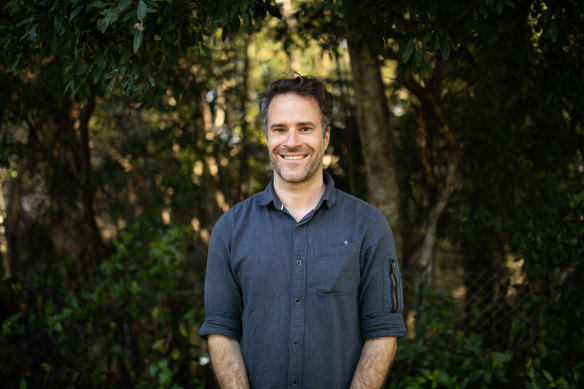
Dr Jean Renouf stressed the importance of counselling services as part of the relief effort. “There’s nothing to be ashamed of if you’re not sleeping well, if you can’t bear the sound of rain.”Credit:
The floods must be seen in the context of the past five years, says Dr Jean Renouf, a lecturer in politics and international relations at Southern Cross University in Lismore, who has a particular interest in resilience, and whose research focuses on the impact of climate change on communities.
“We’ve had the 2017 flood, the 2019-20 bushfires, two years of COVID-19, the ongoing housing crisis and now, two floods in two months,” Renouf says. “These events have really affected people’s capacity to be resilient. There really is no going back to ‘normal’ in this region. The trauma that people are suffering from is directly linked to the floods, but it’s also a trigger for an already existing distress.”
Renouf, who has worked in numerous disaster zones, tells me that it’s important to normalise the trauma. “What we know is that while uncertainty continues, people who have lived through something like this won’t be able to find a sense of dignified self,” he says. “People need tangible aspects – food, water and shelter – to feel secure, but it is also essential that all sorts of counselling services are available. There’s nothing to be ashamed of if you’re not sleeping well, if you can’t bear the sound of rain, if you feel anxiety rising in your body. The recovery process will take years.”
Katie Menzies is an environmental engineer with Australian Wetlands Consulting (AWC), based in the Northern Rivers hill town of Bangalow. The 29-year-old, who has been living in Ballina for three years, grew up in parched Condobolin, with her family property suffering through the Millennium drought.
She explains that AWC has investigated how nature-based solutions might be able to mitigate flooding in Lismore. “One of the options that could work is to use the natural floodplain areas upstream of Lismore to store water,” she says. “It would be possible to create a structure in the riverbank that could divert water into that area. Of course, that alone wouldn’t have stopped the enormous flood we just experienced, and it would have its challenges. Most of the land is privately owned and it’s possible that owners won’t want their land inundated any more frequently.”
While solutions will depend on a cost-benefit analysis, Menzies calls the amount of money spent in Australia on recovery, compared with flood mitigation, “very high” when set side by side with the rest of the developed world. “I think that all the environmental-industry professionals would wish it was more balanced.”
For those of us who have chosen to live in this region, rain and flooding is par for the course. But this, as we all know, was different.
“I can’t stand the sound of the rain,” says Natalie Skillings-Smith. “I hear it now and I just want to cry.” Skillings-Smith, 47, an equestrian coach in the small town of Woodburn, about one hour south of Ballina, runs – or ran – a riding school and agistment centre for horses. Suffering from pancreatitis in the weeks leading up to the flood, she’d had her gall bladder removed and a hernia fixed the week before.
“We had 20 horses on the property,” she says, “and with my 15-year-old daughter, who has an intellectual disability, we managed to move 10 off in the pouring rain as the water first started rising. Three wouldn’t load, and by the time my husband had moved all the machinery and cars to the highest point of our land, I made the decision to move the rest of the horses up there as well. Our house is on a rise, and I knew no flood had ever reached the ridge on the property, so we felt confident that it would be okay.”
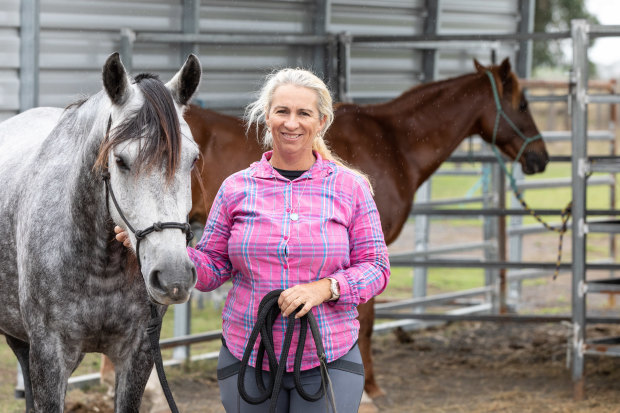
Natalie Skillings-Smith lived on a bridge with several horses for a week before the floodwaters subsided enough for them to leave. “I’m having nightmares to this day.”Credit: Paul Harris
But as dusk fell on the Sunday and the rain poured down, they decided to evacuate in their tinny to nearby Woodburn Bridge, the highest part of the town; water was rising at both ends of the bridge.
It was the start of a long night. “Did you know,” says Skillings-Smith, “cows bellow in distress while they’re drowning, but horses make no noise? All through the night we could hear the sound of the dying cows, bellowing as they floated away. Horses simply swim until they can’t swim any more.
“We could hear people calling out for help from their rooftops, and at first the local SES member wouldn’t rescue them if they had their pets with them, but then people were refusing to leave, so in the end he had to take their animals as well.”
At daybreak, Skillings-Smith and her husband Shane Smith, 50, set off in their boat to check on the horses. They discovered immediately their two small ponies had been washed away. They managed to rescue seven of the remaining horses, and take them, over six hours, back to the bridge. “We lost one, an older stockhorse,” says Skillings-Smith, “and I’m not sure I’ll ever get over the feeling that we could have done more. We lived on the bridge with the horses for a week before the floodwaters subsided enough for us to get them off, and I’m having nightmares to this day.”
Ironically, the flooding river, which had taken so much away from them, became their lifeline for those seven days. “We tapped into a water main,” she says, “and people delivered food by boat and jet-ski, and there were hay drops for the horses and cattle.
“What is amazing is how the community banded together, with people risking their own lives to save other people and animals. Our community’s been working hard to rebuild, and it’s been truly inspiring to see so much help coming in. But even with that support, I think the one need above any other would be for free counselling for everyone who was flood-affected. I believe the mental health of everyone in this region is going to be very fragile for a long time.”
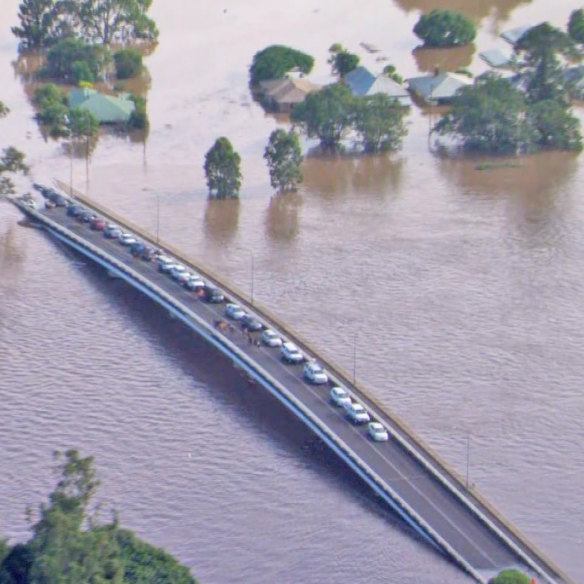
Woodburn bridge, the highest part of the town, became a refuge for many motorists and animals.Credit: Nine
There were miraculous rescues and tragic drownings. Herds of dairy cows were washed away, as were thousands of beef cattle – according to the DPI, too many to give a final count. Precious family pets had to be left behind, many never to be seen again, while some made extraordinary journeys to be reunited with their owners.
Heather Brown (not her real name) had to leave the Ballina Caravan Park, where she was living while looking for permanent accommodation for herself and her three Maltese-Shih-Tzu-cross dogs. The 68-year-old was determined to keep them by her side. “Having a pet with you is what keeps you going,” she says. “You think, ‘I’m homeless, how am I going to deal with this?’ It’s difficult to maintain a level of hope when you’re looking at devastation and loss. There’s nothing pulling you back into your life, but pets give you emotional and psychological attachment. They give you something to live for when you have nothing, when you’re wondering how you’re going to deal with the aftermath. I believe animals play a major role in helping survivors keep going.”
In the first week after the floods, when communities all over the region saved themselves in so many innovative and efficient ways, Grafton-based equine vet Oliver Liyou was an early responder to the animal catastrophe. “Bruno Ros, a vet from Casino, was literally putting his own money on the line to get out there and help,” says Liyou, “so a group of us got together to set up a central command post at the Primex site in Casino to co-ordinate the private veterinary response. We also created a fundraiser which would help to cover the cost of some of the helicopters and the medications for the flood-affected animals, so that we could treat them on behalf of the owners.”
Liyou turned his practice, EVDS, which usually specialises in equine dental and reproductive treatment, into a field hospital, taking in numerous flood-affected horses, some of which are still recovering. He believes that an emergency animal plan for rural and regional Australia, backed by agencies, should be in place, covering air and ground for livestock, pets and native wildlife. And he calls it “miraculous” that communities have achieved what they have.
“There should absolutely be compulsory registration and microchipping for all horses,” he adds. Unlike other livestock, horses are not tagged. “Hundreds of horses were swept away, and when their bodies were found, they were buried without any attempt to identify them, which has caused deep ongoing trauma.”

Equine vet Oliver Liyou turned his dental and reproductive centre into a temporary field hospital with his fiancee Corolyn and horse Larry. Credit: Paul Harris
In a high-level government meeting during the flood event, Liyou learnt that this was the ninth disaster to strike Lismore since 2018. “What shocked me was there was no plan in place to accurately monitor the extent of animal suffering and loss,” he says. “If the private vets hadn’t stepped up to volunteer their help and co-ordinate rescue and feed drops, so many more animals would have been lost. Perhaps now everyone will realise that climate change will continue to bring natural disasters and that we need to prepare better.”
Widjabul Wia-bal elder and Lismore resident Uncle Steven Roberts is proud of the Bundjalung response to the disaster. The Koori Mail, for example, owned by five Indigenous organisations representing the Bundjalung nation, has raised more than $1.2 million so far in a flood fundraiser, and the “mob” came from far and wide to offer help to their Northern Rivers tribe.
“It’s been fantastic, really,” he says, “but if the Lismore City Council had listened to the elders back in the late 1880s into the early 1900s when they were told not to keep on building in the CBD, these floods would not have caused this devastation.” He’s also pleased that NSW Premier Dominic Perrottet has promised that Cabbage Tree Island will be rebuilt for its Indigenous community. “We’ve dealt with it our way,” he says, “and I believe it’s been a good way.”
Stories of tiny miracles have kept many of us going. The guinea pig floating down the river in its cage, plucked to sudden safety by a man in his boat; the 90-year-old woman sitting in floodwaters up to her neck, rescued by two men who heard her crying for help; a Lismore resident who left her five chickens floating in her living room in a tiny tent when she and her dog escaped to her roof, only to find them all alive and well in their buoyant little capsule five days later. Another welcome miracle was the sudden disappearance of the COVID vaccine polarisation, in an area with the highest proportion of anti-vaxxers in the country. Suddenly we were, almost literally, all in the same leaky boat.
As for our little leaky boat: our driveway washed away twice, a horse paddock flooded when the creek rose (I’d taken the horses out), our garage flooded, and water was within five centimetres of coming inside the house – and we live on a hill. My son’s partner, who managed a Lismore cafe, has lost his job, and my son’s small business, which sells to local shops, has been affected. I’m edgy and anxious a lot of the time, mainly because of the terrible wound that’s been inflicted on the area I’ve called home for almost 20 years.
If acceptance is the last stage in the grief cycle, despite the determined efforts of this region to rise above the calamity, we all still have a way to go.
Beyond Blue on 1300 22 46 36.
To read more from Good Weekend magazine, visit our page at The Sydney Morning Herald, The Age and Brisbane Times.
The best of Good Weekend delivered to your inbox every Saturday morning. Sign up here.